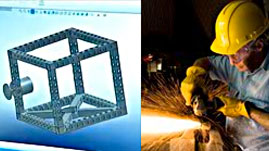Teachers' Domain - Digital Media for the Classroom and Professional Development
User: Preview

Source: Produced for Teachers' Domain
This interactive activity produced for Teachers' Domain investigates five possible career paths in advanced manufacturing technologies: design and development; production and quality assurance; inventory and distribution; health, safety, and environment; and installation, maintenance, and repair. Explore each path to learn more about the education and experience required for particular jobs such as model maker, industrial designer, machinist, quality control inspector, storage and distribution manager, purchasing agent, environmental science and protection technician, industrial safety and health engineer, industrial machinery technician, and industrial electronics technician.
Here are suggested ways to engage students with this interactive activity and with activities related to this topic.
For more media and information about the topics in these Teaching Tips, see these links:
 Loading Standards
Loading Standards Teachers' Domain is proud to be a Pathways portal to the National Science Digital Library.
Teachers' Domain is proud to be a Pathways portal to the National Science Digital Library.
